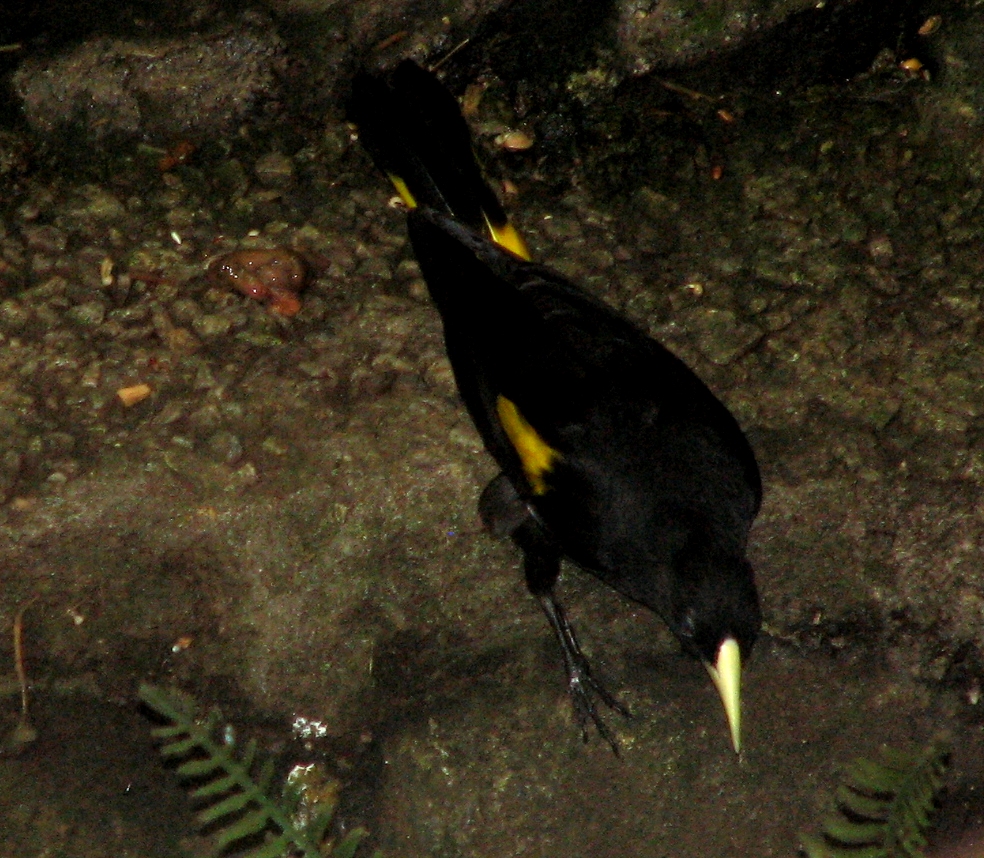Yellow-rumped Cacique (Cacicus cela) - Wiki Yellow-rumped Cacique
From Wikipedia, the free encyclopedia
Order: Passeriformes
Family: Icteridae
[Photo] Yellow-rumped Cacique (Cacicus cela), Cincinnati Zoo and Botanical Garden. Date June 23rd 2007. Author Ltshears (http://commons.wikimedia.org/wiki/User:Ltshears). License: public domain.
The Yellow-rumped Cacique, Cacicus cela, is a passerine bird in the New World family Icteridae. It breeds in much of northern South America from Panama and Trinidad south to Peru, Bolivia and central Brazil.
The Yellow-rumped Cacique is a bird associated with open woodland or cultivation with large trees. It is a colonial breeder, with up to 100 bag-shaped nests in a tree, which usually also contains an active wasp nest. The females build the nests, incubate, and care for the young. Each nest is 30???45 cm long and widens at the base, and is suspended from the end of a branch. Females compete for the best sites near the protection of the wasp nest. The normal clutch is two dark-blotched pale blue or white eggs. Females begin incubating after laying the second egg; hatching occurs after 13 or 14 days. The young fledge in 34 to 40 days, usually only one per nest.
This is a slim bird, with a long tail, blue eyes, and a pale yellow pointed bill. It has mainly black plumage, apart from a bright yellow rump, tail base, lower belly and wing epaulets. The female is smaller and duller black than the male, and the juvenile bird resembles the female, but has dark eyes and a brown bill base.
The male is 28 cm long and weighs 104 g, and the female is 23 cm long and weighs 60 g. This gregarious bird eats large insects and fruit.
The song of the male Yellow-rumped Cacique is a brilliant mixture of fluting notes with cackles, wheezes and sometimes mimicry. There are also many varied calls, and an active colony can be heard from a considerable distance.
The Yellow-rumped Cacique has benefited from the more open habitat created by forest clearance and ranching.
There are three subspecies:
C. c. cela (east of the Andes from the Santa Marta coast of Colombia to central Bolivia and eastern Brazil)
C. c. vitellinus (from the Panama Canal Zone to the base of the Sierra Nevada de Santa Marta and the central Magdalena Valley of Colombia)
C. c. flavicrissus (from Esmeraldas Province, Ecuador to Tumbes Province, Peru).
The latter two may be a separate species, Saffron-rumped Cacique (Jaramillo and Burke 1999).
Folklore
This species, like other cacique species and oropendola species, is called paucar or similar names in Peru (Manu Peru Manu - Aves 2007, Muyuna Amazon Lodge 2005). This species is presumably the one that, according to a folktale of Moyobamba, originated as a rumor-mongering boy who always wore black pants and a yellow jacket. When he spread an accusation against an old woman who was a fairy in disguise, she turned him into a noisy, wandering bird; the bird's appearance is thought to augur good news. It is also said that as the paucar is considered very intelligent, Indians feed the brains to their children to make them fast learners (Moyobamba - Peru 2007).
As the male plays no part in nesting and care of the young, a man who does not work may be called a "male paucar" (Aves en Soritor 2006).
http://en.wikipedia.org/wiki/Yellow-rumped_Cacique
| The text in this page is based on the copyrighted Wikipedia article shown in above URL. It is used under the GNU Free Documentation License. You may redistribute it, verbatim or modified, providing that you comply with the terms of the GFDL. |
